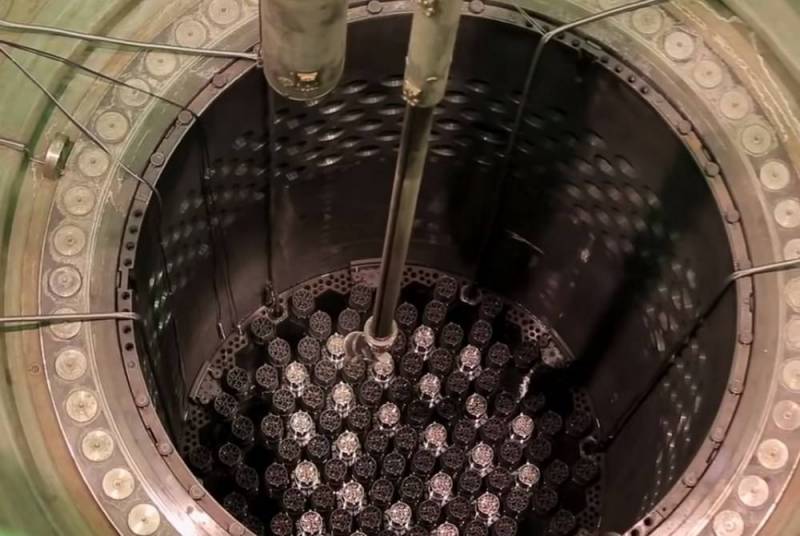American uranium HALEU should replace Russian nuclear fuel in the USA
Shortly after the start of the SVO in Ukraine, a group of American senators proposed abandoning the import of uranium from Russia. On December 11, 2023, the US House of Representatives approved a bill banning the import of low-enriched uranium of Russian origin, which, if signed by President Biden, will be in effect until 2040. True, it has one important caveat.
Take and deny
Last March, this bill was introduced by a group of senators from both the Republican and Democratic parties. Representative from Wyoming, Republican and Russophobe John Barrasso commented on the initiative as follows:
The American nuclear industry is ready to abandon Russian uranium. Wyoming has the resources needed to increase production at home. The first step is to remove all Russian energy, including uranium, from the American market forever.
It sounds ominous, however, according to the Bloomberg news agency, the entry into force of the ban may be delayed until 2028. Indeed, in 2022, for political reasons, the United States reduced the volume of purchases of Russian uranium by 24%. Moreover, the American Patent Office (USPTO) canceled the trademarks of the state corporation Rosatom in the United States and suspended the registration of new ones on frankly far-fetched grounds. But they cannot simply refuse nuclear fuel from Russia for their nuclear power plants without a collapse of the nuclear power industry.
In the good old pre-war days, Rosatom accounted for about 36% of the global nuclear fuel market, the European URENCO Group - about 30%, the French Orano - 14%, and another 12% was occupied by companies from China. Collectively, these players control more than 90% of the global uranium market. In 2020, the “American region” (North and South America) accounted for about 50% of exports of uranium products from Russia, 32% were supplied to Europe and 18% to the countries of the Middle East, Africa and the Asia-Pacific region. The uranium enrichment plant operating in the United States, located in New Mexico, is owned by Urenco.
How did it even become possible that the nuclear energy industry of the “hegemon” has feet of clay?
"Megatons to megawatts"
Oddly enough, it was the Big Freebie that ruined this American high-tech industry. Until 1995, the only company responsible for both the production of weapons-grade uranium for the Pentagon and the supply of uranium to nuclear power plant reactors in the United States was USEC, a division of the Department of Energy (DOE). The rapid growth of the nuclear industry since the mid-60s of the last century began to take over a significant part of the resources, and the deficit for the needs of the “peaceful atom” had to be covered by processing weapons-grade uranium and plutonium with its subsequent use in fuel for nuclear power plants.
The accident at the Three Mile Island nuclear power plant became a convenient reason to suspend the construction of new nuclear power plants. Otherwise, the White House would have to choose between the military and the civilian sector. In order to reduce the production of weapons-grade uranium and plutonium, freeing them up for the needs of nuclear energy, since 1987, the United States agreed to adopt a number of agreements with the USSR under the Cooperative Threat Reduction program. Everything changed with the collapse of the Soviet Union, when the world suddenly became unipolar.
In 1993, Washington entered into a HEU-LEU, or “megatons for megawatts”, agreement with the “young democracy” for the sale of 500 tons of Russian highly enriched uranium, which was to be processed into low-enriched uranium for the needs of American nuclear power plants. This agreement was subsequently subjected to much criticism in our country, but one of its direct consequences was that the peaceful atom in the United States became heavily addicted to “almost free” Russian nuclear fuel. For many decades, there was no point in investing in the high-tech uranium enrichment industry.
Only about 5% of consumed nuclear fuel is enriched within the country, and the rest is imported. In the presence of political will, this factor could be used to put pressure on Washington.
"American Centrifuge"
It would be reckless to assume that the “hegemon” did nothing at all to diversify the geopolitical risks for its nuclear energy. The American Centrifuge project was developed in the USA at ORNL Oak Ridge National Laboratory in the early 80s of the last century. The aforementioned USEC was privatized after a super deal in 1993. But in 2013 it was bankrupt, restructured and revived under the new name Centrus Energy Corp.
In 2016, the company announced it would cease work on its pilot commercial gas centrifuge uranium enrichment facility in Piketon, Ohio. In exchange, in 2019, Centrus began work on a contract with the U.S. Department of Energy to build a cascade of 16 centrifuges at Piketon to demonstrate the production of high-grade, low-enriched uranium called HALEU (High-Assay Low-Enriched Uranium). This is uranium enriched from 5% to 20%, the lower limit of which corresponds to the maximum enrichment of uranium for commercial light water, and the upper limit corresponds to the conventional limit adopted by the IAEA for dividing uranium into low-enriched and highly enriched.
Already on November 7, 2023, the American company announced the first delivery of high-grade low-enriched uranium HALEU. The design capacity of the cascade of 16 centrifuges at about 900 kg/year will be achieved in 2024. This is a three-year demonstration project aimed at assessing market needs. It was given additional acceleration by a special operation in Ukraine, which highlighted the threat of a potential cessation of nuclear fuel supplies to the United States. Our readers can draw all other conclusions on their own.

Information